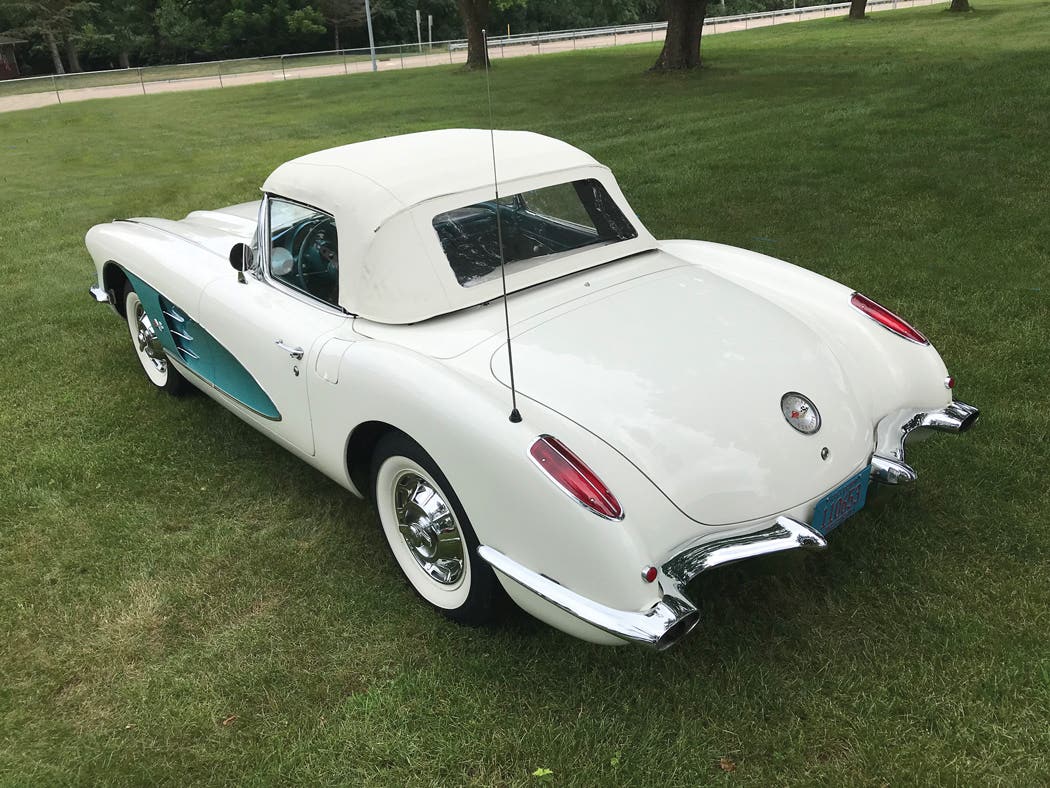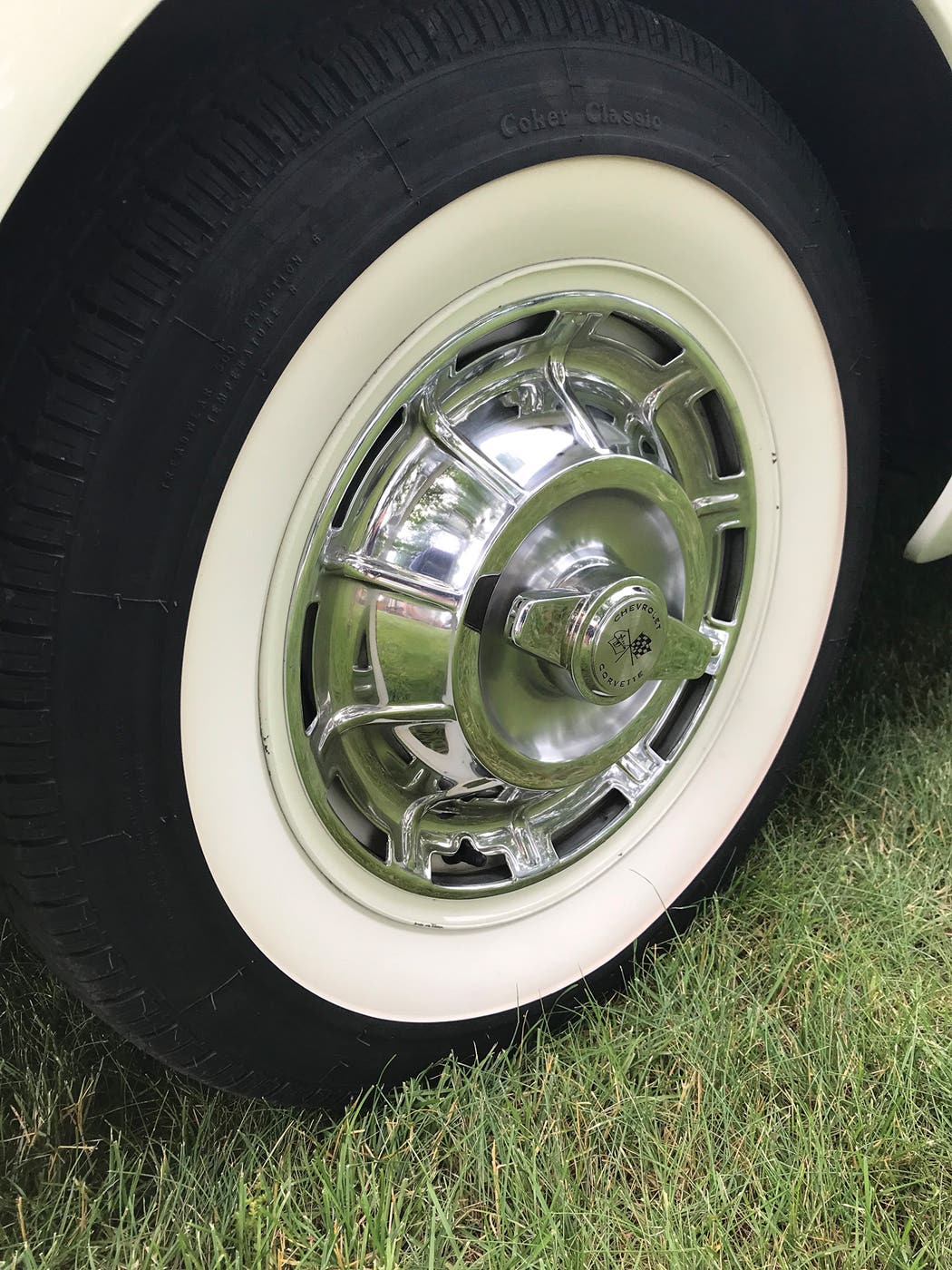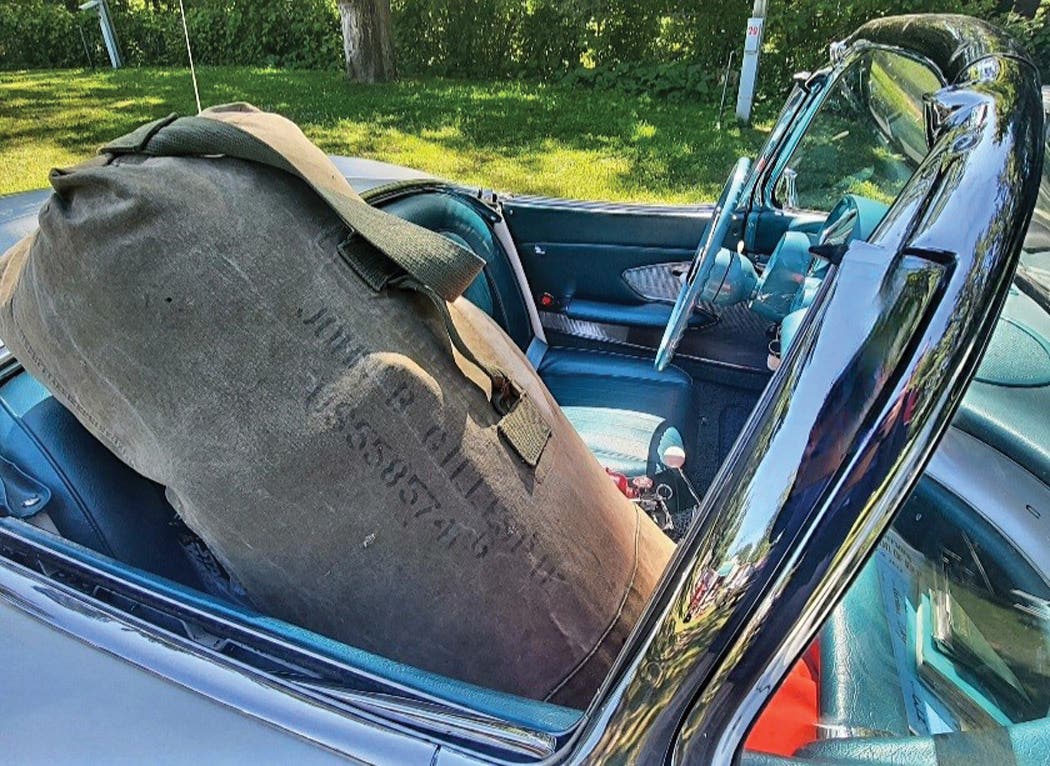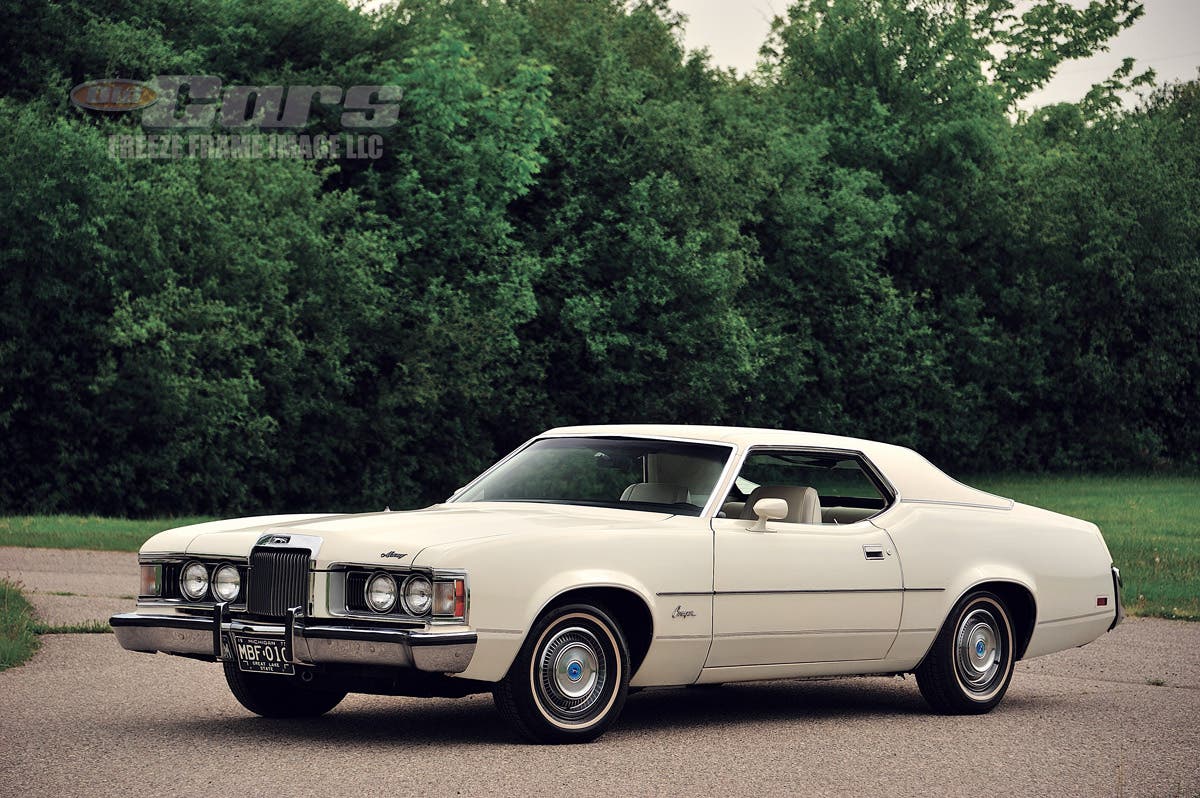Car of the Week: 1960 Chevrolet Corvette… Owned since a toddler
Becoming a Corvette owner as a toddler makes for a lifelong fan.
As the sun set on a warm summer day last July, 35-year-old Brack Gillespie drove home to Green Bay, Wis., from the Iola Car Show with the top down and the sun on his neck behind the wheel of his 1960 Chevrolet Corvette, a car he’s known nearly all of his life. Next to him, in the turquoise passenger seat, was the green canvas duffel bag once belonging to a man he barely knew — his father.
Gillespie’s father, John Brack Gillespie, died when Gillespie was just a year and a half old, so it’s through artifacts such as the Corvette and the duffel bag — and stories related to the Corvette — that he’s come to know about his father.
“There is one story that my uncle always tells me about my dad and the car,” Gillespie says. “My dad outran the Brown County sheriff, the Shawano County sheriff and the reservation authorities to get to Antigo. When he got there, he threw my uncle the keys to the Corvette.”
Gillespie’s uncle had no idea that his brother had just outran authorities with the Corvette in three different counties, which explains his surprise when the law caught up with the car.
“My uncle took his girlfriend in the car and they ended up getting pulled over,” Gillespie said. “My great-grandpa was the sheriff of Langlade County, so my uncle just hopped up on the top cover and says, ‘What can I do for you?’ because his grandpa was a sheriff. The sheriff said, ‘This car is wanted in three different counties,’ and he threw my uncle in the slammer that night. My great-grandpa had to get him out that night.”
Gillespie’s uncle hasn’t held a grudge after all these years and shared with him the history that he recalls of the Corvette. Gillespie was told his father purchased the car in Florida during the 1960s upon returning home from Vietnam, and it was probably the second of the three Corvettes he owned. Apparently the car was one of two 1960 Corvettes bought as a pair by the original owners: an automatic for “her,” and Gillespie’s manual car for “him.”
The three-speed-manual-transmission 1960 Corvette was used by John Gillespie as a daily driver until he loaned it to a friend who got into a fender breaker with a ’60s Pontiac. In the accident, the fiberglass of the Corvette’s front fender was broken at the cove on the driver’s side. Gillespie says his father then parked the car and by 1972, he was disassembling it. It was in pieces when he passed away.
“My dad was always tinkering on something, tearing things apart and putting them back together, probably making them better than they were before,” he said. “He was always tinkering on things since he was a young kid and into adulthood.
“I built metal models as a kid and like to tinker as well,” Gillespie added. “They say they see a lot of my dad in me, and I didn’t even get to meet him.”
When Gillespie’s father died in 1988, Gillespie was but a toddler, yet it was at that point that he became the owner of his father’s 1960 Corvette. The car would be quite a prize for anyone, let alone someone who had just learned the act of walking and had much to learn before mastering a clutch.
Ownership of his father’s Corvette almost didn’t happen, though, because Gillespie’s parents weren’t yet married, and it’s believed his grandfather planned to sell the car.
“When my dad died, my mom was able to get the title in her name and my name somehow,” he said. “I am glad that my mom was able to do that.”
Until Gillespie was old enough to work the clutch, the disassembled Corvette gathered dust in a barn. As a kid, he’d occasionally disturb the accumulating dirty by climbing around the ’Vette and getting behind its wheel, pretending to drive it until the day he could hit the road in it. The car remained in primer and pieces until 2000, about the time Gillespie was transitioning from middle school to high school. At that point, his mother asked him a very serious question that would affect his future.
“When I was 14, my mom asked if I wanted to restore the car or go to college,” Gillespie said. “What’s a 14-year-old boy going to say?”
There wasn’t any doubt; Gillespie chose to have the Corvette restored.
At that point, the Corvette and its boxed parts were retrieved from their long slumber in what had become a “barn find” state and sent to a Corvette restorer in Indiana. Gillespie said despite the car being in pieces, it was very complete, and he doesn’t recall the shop ever contacting them about missing parts. By the time he was 16 years old, the car was ready to drive for the first time in at least 30 years. During the process, he learned he had a pretty rare version of the 1960 Corvette.
“It’s one of 15 in this color combination: Ermine White with a Tasco Turquoise cove,” he was told by the restorer.
Most coves were painted silver or white, a $16.15 option, making Gillespie’s Tasco Turquoise-coved ’Vette a real looker, as evident by the amount of comments he receives. It’s further outfitted with the optional hardtop and signal-seeking radio. Gillespie believes it may have also been originally built as a dual four-barrel car, because it was sent to the restoration shop with multiple carburetors. When it was returned, however, the car’s 283-cid V-8 was fitted with a single four-barrel carburetor, making the engine good for 230 hp.
Once the restoration was completed, Gillespie had the coolest car in the school parking lot.
“My friends liked it; they got a kick out of it,” he said. “They didn’t call me a spoiled kid, because they knew the story behind it. They didn’t say, ‘That’s your daddy’s car,’ and really, it is.”
In the last two decades since he’s had the car restored to its factory-new condition, Gillespie has driven it about 6,000 miles, but only occasionally to car shows. Today, the odometer shows about 93,000 miles since 1960.
Although he hasn’t added many miles, Gillespie says he’s glad he chose to restore the car rather than attend a university. “I am happy I chose the car over college -— I am not book smart, I am street smart,” he says.
His father’s family is also glad it wound up in his hands and back on the road. “My uncles are happy and proud of it,” he says. “I sent a picture of it at the Iola Car Show to my aunt, and she said my dad would be smiling down.”
Even though he was offered six figures immediately after its restoration, Gillespie has no plans to ever part with his father’s Corvette. When the sun finally casts its last light onto Gillespie’s lifelong ownership of the Corvette, he plans to pass it onto someone who’s equally important to him.
“I go to the flea market in it with my godson,” he says. “When I do pass away, it goes to my godson. My instructions to him are to never get rid of this thing. Keep it, figure it out, and never get
rid of it.”
A Peek at the 1960 Corvette
The 1960 Corvette, the eighth such iteration of Chevrolet’s fiberglass sports car, looked much the same as the previous year’s model. A new rear suspension sway bar improved the car’s handling, as did a larger-diameter front anti-roll bar, but underneath, the chassis was essentially the same as the original 1953 model with mild year-over-year improvements. Standard equipment for 1960 included a tachometer, roll-up windows, sun visors, dual exhaust, carpeting, outside rearview mirror and electric clock. Buyers could choose from eight exterior finishes: black, Ermine White, Tasco Turquoise, Horizon Blue, Sateen Silver, Cascade Green, Roman Red and Honduras Maroon. Three colors of convertible tops were offered: black, white and blue. Interiors could be black, blue, red or turquoise.
Five versions of the 283-cid V-8 were offered, with the standard engine carrying a single four-barrel carburetor good for 230 hp. Optional dual four-barrel carburetors provided either 245 hp with hydraulic lifters or 270 hp with solid lifters, and optional fuel injection produced 250 hp with hydraulic lifters or 290 hp with solid lifters. Transmissions offered were a three- or four-speed manual, or Powerglide automatic (the three-speed manual was standard, and 290-hp fuelie cars could only be had with the four-speed manual transmission).
Important dimensions for the 1960 Corvette were 177.2 inches in overall length, an overall width of 72.8 inches and a wheelbase of 102 inches.
All 1960 Corvettes were Chevrolet body style number 60-0867. The factory base price of a 1960 Corvette was $3,872 compared to $2,954 for a V-8 Impala convertible. For the 1960 model year, 10,261 ’Vettes were built, all at the St. Louis assembly plant.
The majority of 1960 Corvettes (50.1 percent) were sold with the removable hardtop, and even
more (51.9 percent) were sold with the optional four-speed manual transmission.




If you like stories like these and other classic car features, check out Old Cars magazine. CLICK HERE to subscribe.
Have you ever wondered what your classic ride is worth? Old Cars has you covered with the Old Cars Report Price Guide. We are your source for unbiased and real-world pricing. Subscribe today and find out what your car is really worth! CLICK HERE to subscribe.
*As an Amazon Associate, Old cars earns from qualifying purchases.





